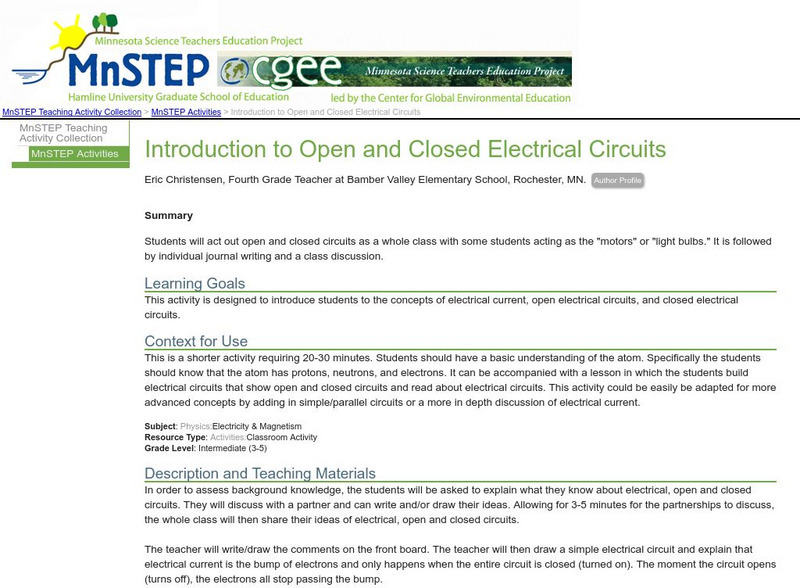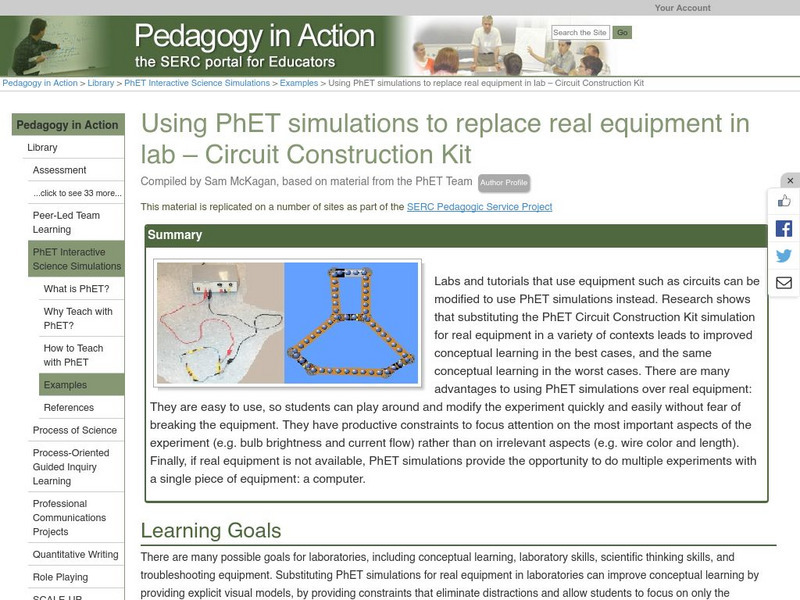TeachEngineering
Teach Engineering: What Is Bluetooth?
Students learn about electrical connections, how they work, and their pervasiveness in our world. Two specific skills explored are Morse code and the function of Bluetooth. Using bluetooth, they control LEGO robots remotely from Android...
Science and Mathematics Initiative for Learning Enhancement (SMILE)
Smile: Electron Current Flow
A teacher lesson plan which could be easily converted into an idea for a student project or presentation. This page describes an activity in which the water-electricity analogy is used to investigate the relationship between current,...
Science Education Resource Center at Carleton College
Serc: Comparing Current Intensities of Series, Parallel, and Complex Circuits
Students will investigate the differences of current in series, parallel, and complex circuits through the construction of a small house containing the different types of circuits.
Science Education Resource Center at Carleton College
Serc: Introduction to Open and Closed Electrical Circuits
This activity introduces students to the concepts of electrical current and open and closed circuits. Students will act out open and closed circuits as a whole class with some students acting as the "motors" or "light bulbs."
TeachEngineering
Teach Engineering: From Sunlight to Electric Current
The lesson will first explore the concept of current in electrical circuits. Current will be defined as the flow of electrons. Photovoltaic (PV) cell properties will then be introduced. This will lead to the principle of "Conservation of...
Science and Mathematics Initiative for Learning Enhancement (SMILE)
Smile: Electric Currents and Circuits
This cooperative learning activity for intermediate to junior high students has them create various electrical circuits in order to understand electricity.
ArtsNow
Arts Now Learning: Using Dance to Explore Electricity [Pdf]
After analyzing examples of conductors and insulators, 5th graders will work in small groups to craft a dance that depicts an electrical current and how it is affected by a conductor or insulator. Students will present their dances to...
TeachEngineering
Teach Engineering: Get Charged!
Students are introduced to the idea of electrical energy. They learn about the relationships between charge, voltage, current and resistance. They discover that electrical energy is the form of energy that powers most of their household...
TeachEngineering
Teach Engineering: Lights Out!
This lesson introduces the concept of electricity by asking young scholars to imagine what their life would be like without electricity. Two main forms of electricity, static and current, are introduced. Students learn that electrons can...
Science and Mathematics Initiative for Learning Enhancement (SMILE)
Smile: Electromagnets
This lesson plan contains several activities designed to help the student understand the magnetic effects of an electrical current.
Science Education Resource Center at Carleton College
Serc: Electric Circuits Guided Inquiry
An electrical circuit guided inquiry where students investigate what an electric circuit is, the main parts of a circuit and the difference between series and parallel circuits. Students groups create a circuit using materials provided...
Science Education Resource Center at Carleton College
Serc: Magnetism and Sound: Creating Your Own Headphones
Students will explore how magnets can create a current by making their own headphones and listening to music from their iPods.
Science Education Resource Center at Carleton College
Serc: Investigating Testing for Electrical Conductivity Using Materials
In this activity, students will understand that electricity moves through different circuits and discover what types of materials are conductors and insulators.
Science Education Resource Center at Carleton College
Serc: Investigating Electricity: Building Circuits in Elementary Science Class
In this exploration activity, students compare the difference between series circuits and parallel circuits using wire, light bulbs, and D batteries.
Science Education Resource Center at Carleton College
Serc: Ph Et Simulations: Replace Real Equipment in Lab Circuit Construction Kit
Students explore with a PhET interactive simulation to replicate the construction of electrical circuits.
TeachEngineering
Teach Engineering: Particle Sensing: The Coulter Counter
Students are presented with a short activity on the Coulter principle, an electronic method to detect microscopic particles and determine their concentration in fluid. Depending on the focus of study, students can investigate the...
Utah Education Network
Uen: Flowing Electrons
For this fifth grade activity, students explore electric circuits by acting out different types, then construct circuits themselves.
Science and Mathematics Initiative for Learning Enhancement (SMILE)
Smile: Series and Parallel Circuits
A teacher lesson plan which could be easily converted into an idea for a student project or presentation. Ideal for pre-high school learners. This page describes an activity in which the history of electric circuits, the nature of...
Better Lesson
Better Lesson: The Lightbulb Just Went On!
Fourth graders discover how electricity can be converted to light energy.
Discovery Education
Discovery Education: Build Your Own Perpetual Motion Machine [Pdf]
A lesson for learners to explore the conversion of energy from electrical energy to kinetic energy by constructing a homopolar motor. Also by constructing the motor, students can investigate magnetism, electricity, and RPM.
Science and Mathematics Initiative for Learning Enhancement (SMILE)
Smile: Resistances in Series and Parallel Circuits
A teacher lesson plan is provided here. This page describes two activities in which the effect of multiple resistors on the current and overall resistance of both series and parallel circuits are investigated. Complete activity...
Science and Mathematics Initiative for Learning Enhancement (SMILE)
Smile: Ohm's Law
For the teacher planning a lesson plan or for the student preparing for a project or presentation. This page describes a series of simple activities related to the voltage-current-resistance relationship.
Science and Mathematics Initiative for Learning Enhancement (SMILE)
Smile: Electrochemistry
A teacher lesson plan which could be easily converted into an idea for a student project or presentation. This page describes activities in which the interconversion of chemical and electrical energy are investigated. Complete activity...
Science and Mathematics Initiative for Learning Enhancement (SMILE)
Smile: Simple Circuitry and Series Circuit
A teacher lesson plan which could be easily converted into an idea for a student project or presentation. This page describes an activity in which the basic nature of a circuit and the concepts of a series circuit are investigated....
Other popular searches
- Static and Current Electricity
- Bill Nye Current Electricity
- Current Electricity Test
- Current Electricity Power
- Electricity Circuits Current
- Current Electricity Review
- Static or Current Electricity
- Statc or Current Electricity
- Static Electricity Current
- Electricity Current








![Arts Now Learning: Using Dance to Explore Electricity [Pdf] Lesson Plan Arts Now Learning: Using Dance to Explore Electricity [Pdf] Lesson Plan](https://d15y2dacu3jp90.cloudfront.net/images/attachment_defaults/resource/large/FPO-knovation.png)















